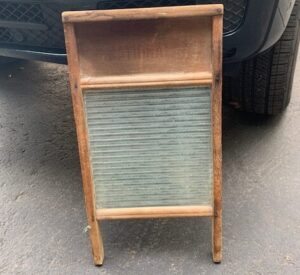 JE owns an early 20th century American washboard use by 1860s across the nation. Stephen Rust of New York invented it in 1833. He patented a wood frame that held a fluted piece of tin, iron, or zinc. These ridges dislodged dirt from clothing. We find advertisements for these things in the mid-19th century. By the later part of the 1800s, Herman Liebmann of Chicago “improved” the boards. He replaced the metal plate insert in the board with ridged glass or porcelain. This is the version JE owns.
JE owns an early 20th century American washboard use by 1860s across the nation. Stephen Rust of New York invented it in 1833. He patented a wood frame that held a fluted piece of tin, iron, or zinc. These ridges dislodged dirt from clothing. We find advertisements for these things in the mid-19th century. By the later part of the 1800s, Herman Liebmann of Chicago “improved” the boards. He replaced the metal plate insert in the board with ridged glass or porcelain. This is the version JE owns.
For years specialist washerwomen went through the ordeal of Laundry Day, if the family afforded such help. In many parts of the world getting cleaning clothes and linens happened once a week, or once a month, or once a year depending on the item. This usually occurred on MONDAY, especially in those traditionally Catholic countries. In many cases it took quite a few days to wash, dry, and fold the linen, and the family wanted peace and no work on Sunday. So easy today to dry a garment in the dryer, but a warm room was hard to find in some parts of the world. Where rainy and cold weather prevailed most of the year, laundry became an ordeal. Sometimes they only did it in the sunlit months.
Before the washboard, washerwomen used washing bats, flat wooden ridged boards with a long handle. They beat and agitated clothing, and lever them from a tub or river. Decorative washing bats were found in the 18th and 19th century in Finland, Norway, and Italy. In England they employed tilted boards with a slope for the water to drain mounted on legs, and placed at the side of a river or tub.
Washing Day in France
 JE also sent me a painting of washing day in France, in the Impressionistic style, with an illegible signature. It shows the early tradition of riverside washing day, a subject beloved by French artists. Two washerwomen, one in a tub or in a three sided box. The other on a ledge, with a pile of linen in the foreground which appears to have been soaked in bluing or lye. A French tradition, the three sided box lined with straw, where washerwomen knelt at the side of the river. The box kept the skirts dry. Across the front at an angle the woman holds a washboard or bat. Some washerwomen in Continental Europe washed on washing benches set in shallow water. They pulverize the fabric with different bats, boards, and plungers, like a toilet plunger, depending on the strength of the fabric and the water flow. Fabrics when wet became heavy so washerwomen became VERY strong.
JE also sent me a painting of washing day in France, in the Impressionistic style, with an illegible signature. It shows the early tradition of riverside washing day, a subject beloved by French artists. Two washerwomen, one in a tub or in a three sided box. The other on a ledge, with a pile of linen in the foreground which appears to have been soaked in bluing or lye. A French tradition, the three sided box lined with straw, where washerwomen knelt at the side of the river. The box kept the skirts dry. Across the front at an angle the woman holds a washboard or bat. Some washerwomen in Continental Europe washed on washing benches set in shallow water. They pulverize the fabric with different bats, boards, and plungers, like a toilet plunger, depending on the strength of the fabric and the water flow. Fabrics when wet became heavy so washerwomen became VERY strong.
Observations in Europe 1844
One travel writer, John Price Durbin, wrote “Observations in Europe 1844” noting the “sturdy washerwomen (the job was physically demanding) by the side of French rivers with a washerwoman’s ark (a little wooden raft) or a bench at the side of the water; the bench was used to souse the clothes which would be beaten with a washing bat after soaking in the river…” I love the old word “souse” which means to drown or make sodden, today associated with a “drunkard!”
Communal washing day among washerwomen was common throughout Europe. They met either at river-edge, in a village washhouse, or at the public fountain in the main square. In France the bateau-lavior, a communal laundry boat, moored close to the riverbank.
JE’s washboard is a common antique as most American homes possessed one, even after the invention of the mechanical washing machine with a drum in the 1860s. Of course not every American household afforded such a thing, so washboards and tubs were de rigor. The value today is $50.
Cool column on Washboards… I have one with the ridged glass. Now I know more about it. Thanks